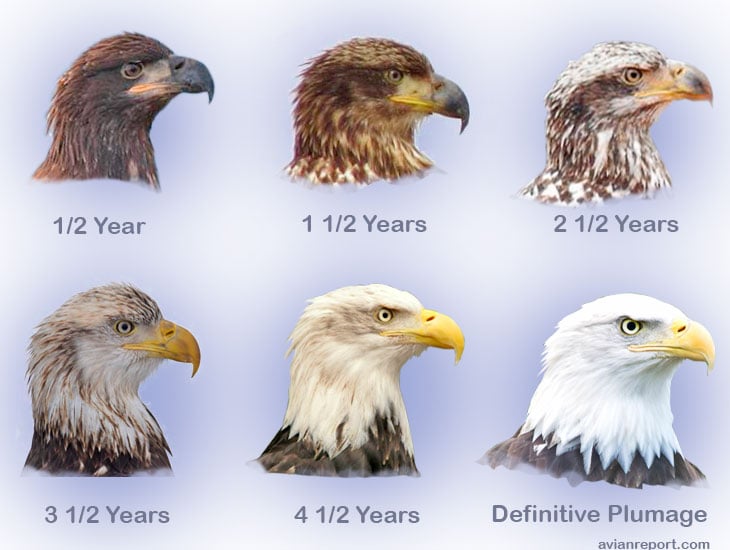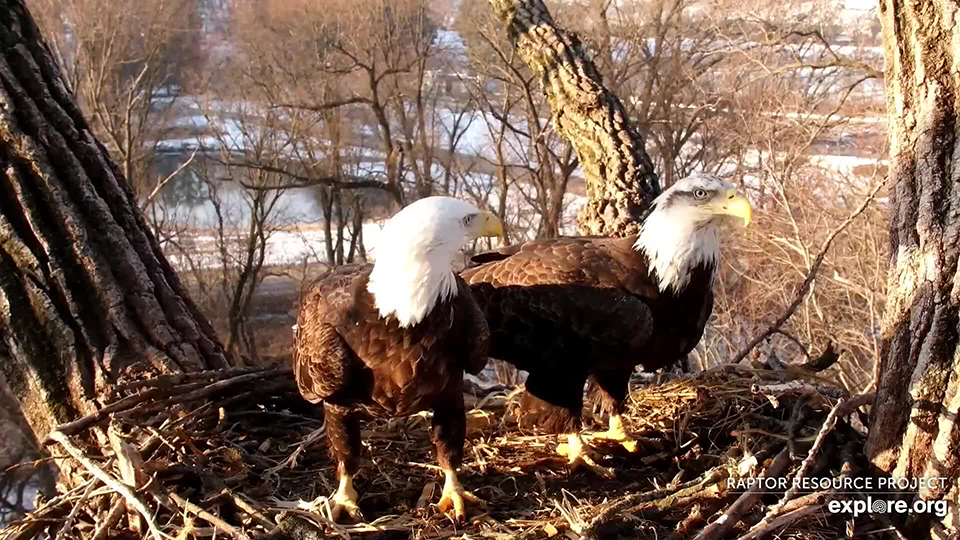How old are the eagles we saw at N2B this morning? Is the female old enough to lay eggs? Will Mom and DM2 object? We’ve left the Confusion Couch for the Decorah Tilt-A-Whirl, but we’ll answer your questions as best as we can!
How old are the eagles we saw at N2B this morning?
The male eagle is over five years old, although we aren’t sure how old he is. Eagles complete their transition to adult colors (white head and tail, dark body) between five and six years of age.
The female eagle is four to five years old. The excellent book In-hand Guide to North American Diurnal Raptors describes 4/5 year old Bald Eagles as Dark overall, belly typically dark, head and tail often mostly white. Wings may have a complete set of adult remiges or retain a few sub-adult secondaries that have white mottling. It describes 5/6 year old Bald Eagles as Dark wings and body with white head and tail that have minimal markings left. Wings have two to three generations of adult remiges.

Aging eagles, author unknown. Based on work by Jerry Ligouri, Mark Stahlmaster, and many others.
So is she four or five? Based on the widely-circulating image above, she is four years old but, as Handbook points out, five-year-old eagles can still have a fair amount of brown on their heads. If she sticks around, we’ll be looking at her secondaries and P10 feather. Four-year-old eagles are a little more likely to have some sub-adult secondaries (look for white mottling and slightly browner feathers) and a retained hatch-year P10 (a retained hatch-year feather will be quite a bit browner than an adult feather). We invite you to look with us!
Is she old enough to lay eggs?
If she’s five, she could lay eggs. A four year-old eagle is not, based on everything we know, sexually mature and so cannot lay eggs.
Why doesn’t the male already have a nest?
That’s a complicated question! To begin with, we don’t know that he didn’t have a nest. While eagle divorce isn’t common, he could have been chased off a nest somewhere else. As the the eagle population grows, nest competition increases.

March 4, 2021: Male eagle left, female eagle right
Could he never have nested? Sure! At one point, some raptor researchers thought that all birds began breeding as soon as they reached sexual maturity (note: Bob knew better). However, we quickly learned that wasn’t the case. Some birds begin breeding immediately, while others delay nesting until later in life. These birds might face more competition, be less aggressive, or be less inclined to settle down. Here’s what we know: the nest is there, the male is an adult, the female may be an adult, and it’s that time of the year.
Even if she doesn’t lay eggs this spring, he might reap some benefits from feeding her now. Male Peregrine Falcons sometimes feed migrant females who are passing through their territories. In two cases that we know, the female returned to mate with the male next year, presumably because he fed her the previous fall. A little investment now might pay off next season!
Do Mom and DM2 know? What will they do?
We can’t see Mom and DM2 from our cameras and they can’t see the hatchery. Since they are incubating eggs and we haven’t seen them at the hatchery since February 23, we suspect they don’t know. If they do, they don’t seem inclined to act on it. In suitable territory, biologist Mark Stalmaster found that the average distance between bald eagle nests was between one and three kilometers. We cannot disclose the location of the new nest, but it is further than a kilometer away.
We know that Decorah is rich in food resources. We’ll see how Mom and DM2 react if the new eagles stay! Thanks to JFDecorah for the heads up this morning, to Paula Bockman for the Tilt-A-Whirl reference, and to our wonderful camera operators and videomakers for finding and sharing special moments like this, and to our busy mods for all they do to keep us informed. You rock!
 The Raptor Resource Project
The Raptor Resource Project The Raptor Resource Project
The Raptor Resource Project